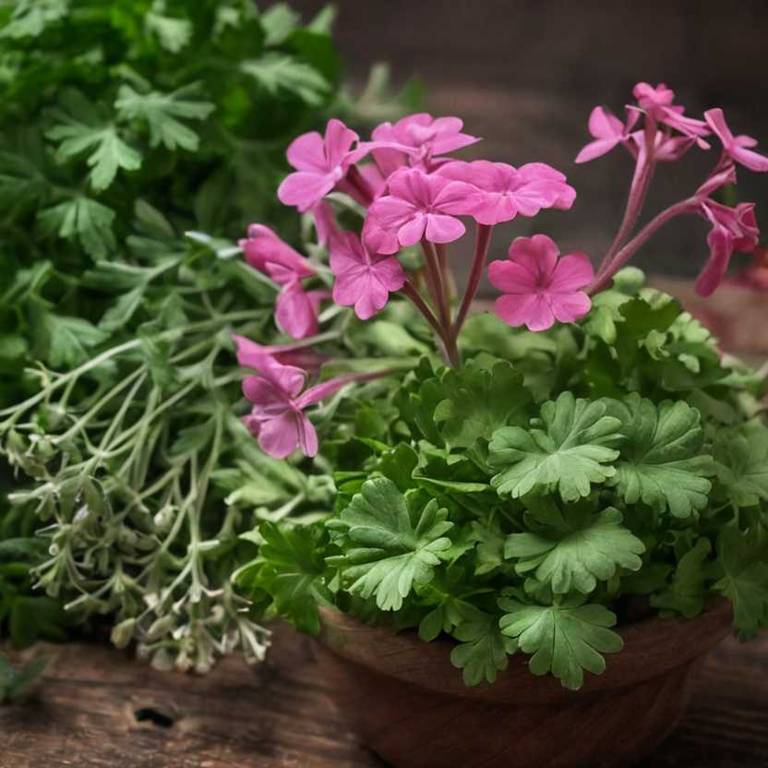By Leen Randell
Updated: Jul 26, 2024
What to know about Pelargonium (scented geranium) before using it medicinally

Pelargonium, commonly known as scented geranium, is a herb renowned for its medicinal properties that promote relaxation, reduce stress, and alleviate digestive issues.
As a versatile and low-maintenance ornamental plant, it is prized by gardeners for its attractive foliage, vibrant blooms, and adaptability to various environments. From a botanical standpoint, Pelargonium species are classified as members of the Geraniaceae family and are distinguished by their distinctive leaf morphology and floral structures.
Historically, this herb has been mentioned in ancient texts, such as the 16th-century herbal of John Gerard, who noted its fragrance and medicinal uses.
This article explains the medicinal, horticultural, botanical, and historical aspects of Pelargonium.
What are the medicinal properties of Pelargonium?
Pelargonium helps with stress relief, anxiety, and sleep disorders. It is used in aromatherapy to promote relaxation and calmness. Its fragrance has also been shown to improve mood and reduce fatigue.
The active constituents of Pelargonium include geraniol, linalool, and borneol, which are responsible for its medicinal properties. These compounds have been shown to have antibacterial, anti-inflammatory, and antioxidant effects. They also possess sedative and antispasmodic properties.
The leaves, stems, and flowers of the Pelargonium plant are most commonly used for medicinal purposes. The leaves are rich in essential oils, while the flowers are high in flavonoids and phenolic acids. The stems are used in traditional medicine to treat various ailments.
When used improperly, Pelargonium can cause skin irritation, allergic reactions, and gastrointestinal upset. Ingestion of large amounts can lead to vomiting, diarrhea, and abdominal pain. Excessive use can also interact with certain medications, such as blood thinners and diabetes medications.
When using Pelargonium medicinally, it is essential to follow proper dosing and preparation guidelines. Pregnant and breastfeeding women should consult a healthcare professional before using the plant. The plant should be used under the guidance of a qualified healthcare practitioner, especially in cases of severe anxiety, depression, or other serious medical conditions.
What are the horticulural aspects of Pelargonium?
Pelargonium grow well in well-drained soil with full sun to partial shade. They thrive in temperatures between 65-75°F (18-24°C) and require regular watering, but not overwatering, which can lead to root rot.
For optimal growth, plant Pelargonium in a container or garden bed with a slightly acidic soil pH (around 6.0-6.5). Avoid planting in areas prone to frost, as this can damage the plant. Space plants about 12-18 inches apart to allow for proper air circulation.
Harvest scented geranium leaves and stems as needed, pinching off flower buds to direct the plant's energy towards leaf growth. Pinch off weak or leggy stems to maintain a bushy shape. Harvest flowers for use in potpourri or as a decorative garnish.
Common pests affecting Pelargonium include mealybugs, spider mites, and scale. Diseases such as root rot, leaf spot, and powdery mildew can also occur. Regularly inspect plants for signs of infestation or infection, and take prompt action to treat affected areas.
What are the botanical aspects of Pelargonium?
Pelargonium is a genus of flowering plants with succulent leaves and stems, bearing small, showy flowers in shades of pink, red, white, and purple. Leaves are aromatic, often with a rose or lemon fragrance. Stems are hairy, branched, or unbranched.
Botanically classified as a member of the family Geraniaceae, Pelargonium is closely related to the geranium and orpine genera. It belongs to the order Geraniales, along with other flowering plants like the geranium and stork's-bill. Its taxonomic classification is as follows: Kingdom: Plantae, Clade: Angiosperms, Clade: Eudicots, Clade: Rosids, Order: Geraniales, Family: Geraniaceae.
Several variants of Pelargonium exist, including the zonal, ivy-leaved, and trailing types. Zonal geraniums have distinct, ring-shaped markings on their leaves, while ivy-leaved geraniums have narrow, pointed leaves that resemble those of ivy. Trailing geraniums, on the other hand, have stems that grow long and trailing, often used in hanging baskets.
Native to South Africa, Pelargonium species are widely cultivated and naturalized in many parts of the world, including the United States, Europe, and Asia. They thrive in warm, dry climates with well-drained soil, often found growing in rock crevices and along roadsides.
The life cycle of Pelargonium begins with seed germination, followed by vegetative growth, flowering, and seed production. Germination typically occurs within 1-2 weeks, after which the seedling develops leaves and stems. Flowering usually occurs after 6-12 months of growth, producing showy flowers that attract pollinators.
What are the historical aspects of Pelargonium?
Pelargonium is a plant that has been used for medicinal, culinary, and fragrant purposes throughout history. Its leaves were used to treat digestive issues, wounds, and fever, while its roots were used as a diuretic. In traditional medicine, it was often combined with other herbs to enhance its effectiveness.
In Greek mythology, Pelargonium was associated with the goddess Hestia, who was revered for her domestic skills, including cooking and healing. The plant's sweet fragrance was said to evoke the goddess's warmth and hospitality. According to legend, the goddess used Pelargonium to prepare medicinal remedies.
In the Victorian era, Pelargonium was a popular symbol of love, prosperity, and good fortune. Its flowers were used to express admiration and gratitude, while its leaves represented fidelity and loyalty. The plant's symbolic meanings were often used in flower language and wedding bouquets. In some cultures, Pelargonium was seen as a harbinger of good luck and prosperity.
Historical texts, such as Dioscorides' "De Materia Medica" (circa 50-70 AD) and Gerard's "Herball or Generall Historie of Plantes" (1597), documented the medicinal properties and uses of Pelargonium. The plant was also mentioned in the works of Arab and Persian botanists, who valued its fragrance and medicinal properties.
Historical artifacts, such as ceramic pots and textiles, featuring illustrations of Pelargonium, have been found in archaeological excavations in ancient Greece, Rome, and China. These artifacts demonstrate the plant's widespread use and cultural significance throughout history. In some cases, the plant's image was used as a symbol of status and wealth.